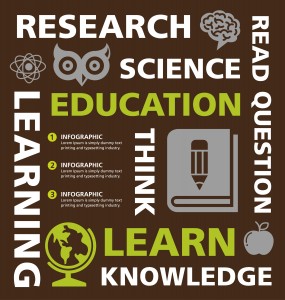At its best, business blogging is an art AND a science.
The art is taking readers on a journey that both soothes their headaches and inspires their ambitions.
The science is showing a clear path to where they want to go.
Great art understands what an audience feels and makes an emotional connection. Sound science stands up to robust examination and creates new opportunities.
In blogging, one won’t survive the acid test without the other. Achieve both and the possibilities are exhilarating.
 Finding the sweet spot
Finding the sweet spot
We live in exciting times for businesses of all sizes to connect with clients in ways not thought possible a few short years ago.
Some have mastered the art of communication. Others grasp the science of forging new relationships by freely sharing their skills and knowledge.
Both get a tick from me. Ultimately, employing one technique or the other works to a point but soon runs out of steam.
Few successfully blend both because, in business, finding good storytellers who also have an impressive story to tell is rare.
Why does it all go wrong? Impatience, greed, poor advice, lack of planning, no strategy? Take your pick. They all apply.
MORE: Why Your Content Marketing Strategy Isn’t Working For You
The times are changing
As one of the cornerstones of content marketing, blogging for business remains an ever-moving target and your content team and blog writers need to keep up.
What works this year might not work as well next year. Constantly raising the bar is critical.
Michael Stelzner, the founder of Social Media Examiner, explains.
“You have to accept the fact that this (content marketing) is going to be gruelling, difficult, time consuming, and laborious work. But if you’re willing to roll up your sleeves and get dirty, and are willing to constantly analyse what you’re doing, and scrap what doesn’t work, and continue what does work, and keep at it, you can be very, very successful.”
MORE: 21 Dangerous Blogging Mistakes (and How to Fix Them)
 In 2015, the best business blogs shifted primarily from telling audiences what they need to showing them how to achieve what they want.
In 2015, the best business blogs shifted primarily from telling audiences what they need to showing them how to achieve what they want.
Prolific content marketing author and founder of the Content Marketing Institute, Joe Pulizzi, says the evolution is set to continue as customers become more sophisticated.
“Good content marketing makes a person stop, read, think and behave differently. More and more, I find that the best content programs revolve around aspirations, not needs.”
MORE: 5 Content Marketing Trends to Consider in Your 2015 Strategy
Blog methodology
How do you apply these principles to get more out of your business blogging efforts?
I’ve broken it up into four stages – planning, executing, measuring, improving – and I call it the Blog Life Circle. For the circle to stay in balance, equal attention must be given to each stage and, to ensure continuous improvement, the cycle must not be broken.
Planning
- Know your audience: Define who you are writing for, what they aspire to achieve, and what information you can provide to help them make decisions. Introduce your blog to readers by including an outline of what they can expect to get, how it can help them and why they should keep coming back for updates.
- Create editorial calendars: Struggling for ideas? Check out what competitors are writing, do some keyword research to determine what your clients are searching for and bring your own character, knowledge and flair to the topics. Spell out what each blog is about, it’s broad title, how it will be promoted, on which channels, and what its goals are – brand building (reach), engagement (comments, shares, likes etc), leads (enquiries), sales etc. Learn How to Create a Content Marketing Calendar.
- Assign responsibility: Determine in advance who writes the blogs. Is it all up to you, shared amongst staff, hired out to an external content agency or a combination of all three? Leave long deadlines to allow for contingencies.
- Post at regular intervals: If you blog well, the audience will want more. Blogging erratically hurts your SEO, annoys your audience and probably does more harm than good. Most successful business blogs publish weekly, sometimes more, and they deliver different content for different audiences.
- Promotion: Define the channels, budgets and methods for promoting your blog content to a wider audience.
MORE: How to turn your business blog into a goldmine
Executing
- Write for readers, not for Google: Trying too hard at most things usually doesn’t get the best results. It’s no different for business bloggers. Blow your audience away with your insight and understanding of the subject, not by artificially inflating the volume of keywords to trick Google into believing how clever you are. It doesn’t work anymore.
- User-friendly and easy to read: Gripping headlines act as a hook. Well ordered, easy to navigate articles featuring sensible sub headings, eye-catching images, embedded video, relevant internal and external links and common language – not business jargon – win every time.
- Avoid personal sob stories and being too promotional: Business blogging should provide value, insight and compelling reading. It’s not about you, your company, your products or services. What do your customers care about? How do you solve their problems, relate to their frustrations, ease their pains? Maintain dignity and stay professional at all times. Readers don’t want to know how hard you’ve worked or the adversity you’ve had to overcome to be successful. It’s irrelevant and self-serving.
- Be original but not evangelical: Private thoughts and beliefs are best logged in a personal diary. Keep the content down to earth, offer real help, source and link to information you have drawn on from elsewhere. It’s OK to quote. It’s dangerous and misleading to copy. Be detailed and generous in sharing your wisdom. Not confident you can put your ideas and knowledge into words? Hire someone who can.

- Draft, edit, redraft, check and test: Typos, grammatical errors, broken links, badly cropped images are all distractions that dilute your message and call your credibility into question. If you care so little about how you present yourself, alarm bells could start ringing about how you might treat your customers.
- Be engaging: Ask questions, encourage feedback. Generating audience interaction is what you want. If readers have learnt something and you demonstrate you’re happy to hear their feedback, everyone’s a winner! Comments on your blog deserve timely and humble responses. Blogs are designed for two-way traffic. They open doors, start conversations, raise more questions, inspire reactions. That’s why they exist. DON’T IGNORE COMMENTS – even if they are critical or take an opposing view. Inspiring someone to challenge your opinions is a great chance to explain yourself further and learn from the experience of others.
Measuring
- Metrics that matter: Objectives were set in the planning stage. Whether your goal was to reach new audience (brand building), start conversations (engagement), boost traffic to the website or blog pages (clicks) or expand the blog subscriber list, now is the time to measure the metrics and record the results. Did you hit your targets? Building an audience for a new blog takes time. Be patient, follow the rules in the planning and executing stages and the audience will grow.
MORE: Digital Marketing: Metrics That Matter
Improving
- Review and reset: This is the fun bit, but you must be honest and focused on producing better outcomes with every blog you produce. Did you promote the blog enough on social media, other parts of the website, other industry channels? Did you target the right audience? Did your blog resonate? Was it useful? Did you plan the content properly? Were there any errors in logic or was it too promotional, self-serving, evangelical or personally revealing?
- Make the changes: Perfection should be elusive. Arriving at that destination is acknowledgment you have nothing more to say. If you have millions reading your blog, there’s a good chance you’re doing something right but it’s no time for complacency. Staying on top of your brief is vital. Aim to be a trendsetter, rather than a crowd follower.
- Read lots: Reading the best blogs in your niche – and the best business writers whether they blog or not – will keep your ideas and writing fresh. Don’t be afraid of being opinionated or even controversial, but always support your arguments with real evidence and be prepared for negative feedback. Not everyone will agree with or appreciate you. Don’t be afraid of asking what your audience wants.
Thirty years of writing stories of all sorts for newspapers and magazines, blogs for marketing firms and press releases for businesses and individuals has taught me one thing: Never assume you know it all. There is always someone, somewhere you can learn from who will educate you and improve your writing.





